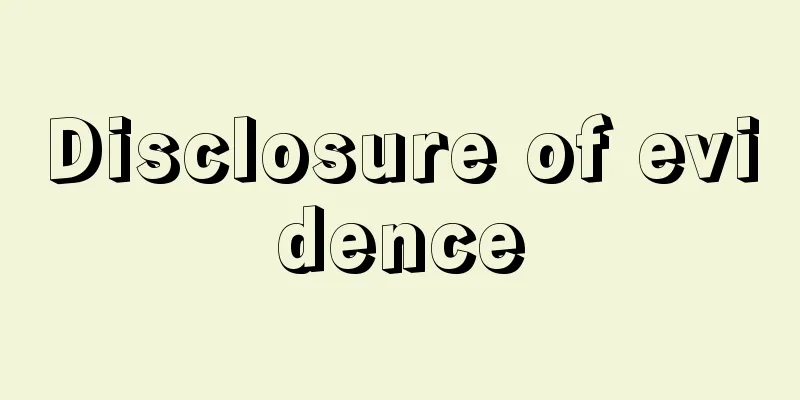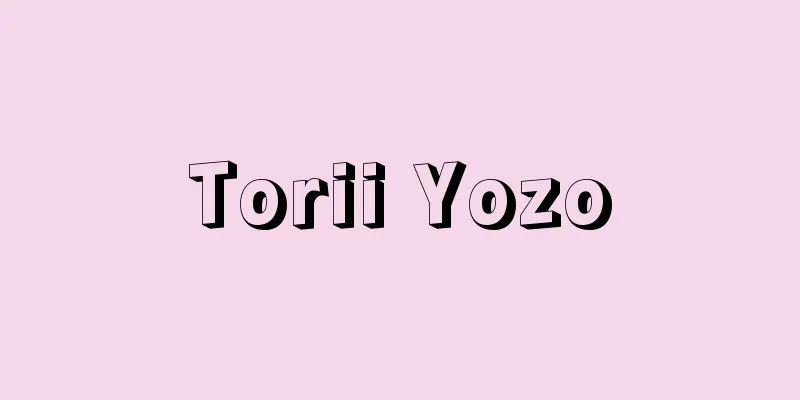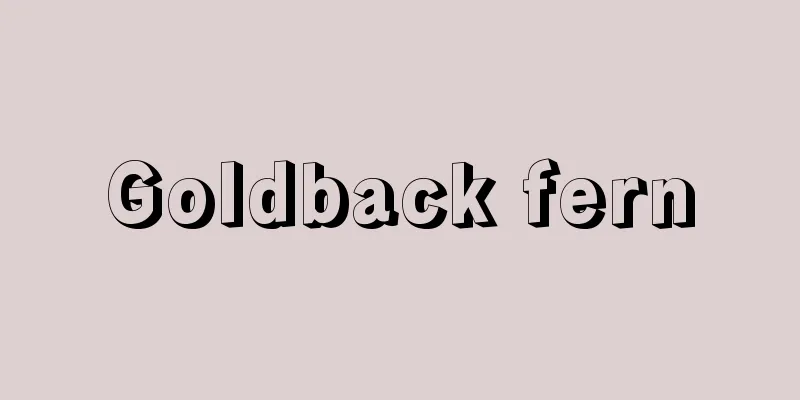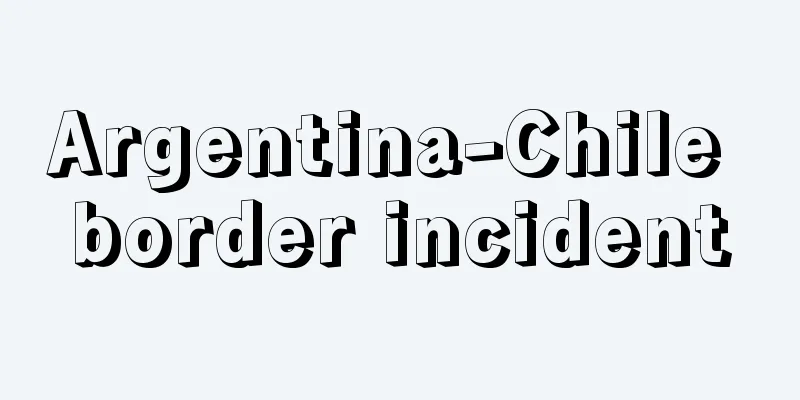Disclosure of evidence

|
This refers to one party in a criminal trial allowing the opposing party to inspect evidence in his/her possession. Article 40 of the Code of Criminal Procedure stipulates that after the indictment is filed, the defense attorney may inspect and copy documents and exhibits related to the trial in court. However, due to the principle of a single indictment, evidence is not submitted to the court in advance, and the contents of the evidence cannot be known in advance in court. This is where the disclosure of evidence in the prosecutor's possession to the defense attorney becomes an issue. [Soriichi Taguchi April 18, 2018] Order to disclose evidence based on litigation control authorityWhen a party requests the examination of evidence, the other party must be given an opportunity to view it in advance (Criminal Procedure Law, Article 299, Paragraph 1). However, evidence that is not intended to be examined will not be disclosed. Therefore, precedent has stated that "when, after the examination of evidence has begun, a defense lawyer requests that the prosecutor be ordered to have the defense lawyer view certain evidence, the court may, taking into consideration the nature of the case, the state of the trial, the type and content of the evidence sought to be viewed, the timing, extent and method of viewing, and other circumstances, order the prosecutor, under its power of directing the proceedings, to have the defense lawyer view the evidence in its possession if it deems it appropriate, as it is particularly important for the defense of the defendant and there is no risk of destruction of evidence or intimidation of witnesses" (Supreme Court, Second Petty Bench Decision, April 25, 1969). This led to a certain level of disclosure of evidence, but the time and scope of disclosure were limited. [Ichiro Uchida and Morikazu Taguchi, April 18, 2018] Disclosure of evidence through pretrial proceedingsThe scope of evidence disclosure has been dramatically expanded by the pretrial preparation procedure introduced by the amendment of the Code of Criminal Procedure in 2004. When the court deems it necessary to conduct thorough trial proceedings continuously, systematically and promptly, it may, at the request of the prosecutor, defendant or defense counsel, or on its own initiative, decide to refer the case to pretrial preparation procedures before the first trial date as a trial preparation to organize the issues and evidence of the case (Criminal Procedure Code, Article 316-2). Since prior disclosure of evidence is essential to organize the issues and evidence of the case, a new system of evidence disclosure in pretrial preparation procedures has been established. The newly established evidence disclosure system has three stages. (1) The prosecutor must promptly disclose evidence requested for examination (evidence requested by the prosecutor) to the defendant or defense counsel (Article 316-14 of the same law). This is called disclosure of requested evidence. In order for the defendant or defense counsel who has received disclosure of requested evidence from the prosecutor to decide whether to request further disclosure of evidence, the prosecutor needs to understand the entire evidence in his/her possession. Therefore, the 2016 amendment to the Code of Criminal Procedure requires that after disclosure of requested evidence, the prosecutor must promptly provide the defendant or defense counsel with a list of evidence held by the prosecutor (in practice, this is also called an evidence list) upon request by the defendant or defense counsel. (2) When a public prosecutor receives a request from a defendant or his/her defense counsel for disclosure of evidence other than that disclosed under (1), which falls under any of the types set out in the law and is deemed important in determining the probative value of a particular evidence requested by the public prosecutor, the public prosecutor shall promptly disclose the evidence if it is deemed appropriate, taking into consideration the degree of necessity of disclosure for the defense of the defendant and the content and degree of harm caused by disclosure (Article 316-15 of the same law). This is called disclosure of type-based evidence. There are nine types of evidence listed in the law, including statements of witnesses requested by the prosecutor (Article 316-15, item 5-i), and records of the date, time, place, and other circumstances of the interrogation of a person in physical custody are also subject to disclosure. However, with the 2016 amendment to the Code of Criminal Procedure, the documents included not only the defendant but also the interrogation of accomplices (Article 316-15, item 8), and many of the evidences that were previously subject to disputes over disclosure are now subject to disclosure. Furthermore, (3) when the defendant's side clearly indicates the issues, the prosecutor shall promptly disclose evidence that is deemed relevant to the issues, taking into consideration the degree of relevance, the degree of necessity for the defendant's defense, and the degree of harm that would accompany disclosure, if deemed appropriate (Article 316-20). This is called disclosure of evidence related to the issues. There are three types of rulings by the court when adjustments are required in the above evidence disclosure procedures. The first is a ruling on the timing, method, or conditions of evidence disclosure (Article 316-25 of the same law). The second is an order to disclose evidence (Article 316-26 of the same law). The third is an order to produce evidence (Article 316-27, paragraph 1 of the same law) and an order to produce a list of the titles of evidence (Article 316-27, paragraph 2 of the same law) when necessary for the above rulings. In addition, with the expansion of the evidence disclosure system, regulations regarding the properness of evidence disclosure practices have also been established. Defense attorneys must properly manage the disclosed evidence and must not arbitrarily entrust its custody to others (Article 281-3 of the same law). In addition, the defendant or defense attorney is prohibited from using the disclosed evidence for purposes other than those for which it was disclosed (Article 281-4, paragraph 1 of the same law). [Soriichi Taguchi April 18, 2018] [References] | |Source: Shogakukan Encyclopedia Nipponica About Encyclopedia Nipponica Information | Legend |
|
刑事訴訟において一方の当事者が、相手方当事者に対して、手持ち証拠を閲覧させることをいう。刑事訴訟法第40条は、公訴の提起後、弁護人は、裁判所において、訴訟に関する書類および証拠物を閲覧し、かつ謄写することができると規定している。しかし、いわゆる起訴状一本主義の原則から、裁判所に事前に証拠が提出されることはないので、裁判所において証拠の内容を事前に知ることはできない。そこで、とくに弁護人に対する検察官の手持ち証拠の開示が問題となる。 [田口守一 2018年4月18日] 訴訟指揮権に基づく証拠開示命令当事者が証拠調べを請求するにあたっては、あらかじめ相手方にこれを閲覧する機会を与えなければならない(刑事訴訟法299条1項)。しかし、証拠調べを請求する意思のない証拠は、これによっては開示されない。そこで、判例は、「裁判所は、証拠調べの段階に入った後、弁護人から、具体的必要性を示して、一定の証拠を弁護人に閲覧させるよう検察官に命ぜられたい旨の申出がなされた場合、事案の性質、審理の状況、閲覧を求める証拠の種類及び内容、閲覧の時期、程度及び方法、その他諸般の事情を勘案し、その閲覧が被告人の防禦(ぼうぎょ)のため特に重要であり、かつこれにより罪証隠滅、証人威迫等の弊害を招来するおそれがなく、相当と認めるときは、その訴訟指揮権に基づき、検察官に対し、その所持する証拠を弁護人に閲覧させることを命ずることができる」(昭和44年4月25日最高裁判所第二小法廷決定)とした。これによって、一定範囲の証拠開示がなされるようになったが、開示の時期、範囲は限定されたものであった。 [内田一郎・田口守一 2018年4月18日] 公判前整理手続による証拠開示2004年(平成16)の刑事訴訟法改正により導入された公判前整理手続により、証拠開示の範囲が飛躍的に拡大された。裁判所は、充実した公判の審理を継続的、計画的かつ迅速に行うために必要があると認めるときは、検察官、被告人もしくは弁護人の請求によりまたは職権で、第1回公判期日前に、事件の争点および証拠を整理するための公判準備として、事件を公判前整理手続に付する決定をすることができる(刑事訴訟法316条の2)。事件の争点および証拠を整理するためには、事前の証拠開示が不可欠であることから、公判前整理手続における証拠開示の制度が新たに整備された。 新たに整備された証拠開示制度は、3段階にわたっている。(1)検察官は、取調べを請求した証拠(検察官請求証拠)については、速やかに、被告人または弁護人に証拠開示をしなければならない(同法316条の14)。これを請求証拠の開示とよぶ。検察官から請求証拠の開示を受けた被告人または弁護人が、さらに証拠開示を請求するかどうかを判断するためには、検察官が手持ち証拠の全体を把握する必要がある。そこで、2016年の刑事訴訟法改正により、請求証拠の開示をした後、被告人または弁護人の請求があるときは、検察官は、速やかに、被告人または弁護人に対し検察官が保管する証拠の一覧表(実務上、証拠リストともよばれる)の交付をしなければならないものとされた。(2)検察官は、(1)で開示した以外の証拠であって、法律が掲げる類型のいずれかに該当し、かつ、特定の検察官請求証拠の証明力を判断するために重要であると認められる証拠について、被告人または弁護人からの開示請求があった場合、被告人の防御の準備のために開示の必要性の程度と開示による弊害の内容・程度を考慮し、相当と認めるときは、速やかに開示する(同法316条の15)。これを類型証拠の開示とよぶ。法律が掲げる類型証拠は9種類あるが、そのなかには、検察官が証人尋問を請求した者の供述録取書等(同法316条の15第5号イ)も含まれ、さらに、身体の拘束を受けている者の取調べに関し、その年月日、時間、場所その他の取調べ状況を記録したものも開示対象とされるが、2016年の刑事訴訟法改正により、そこには被告人のみならず共犯者の取調べ状況の記録書面も含まれることとなり(同法316条の15第8号)、従来証拠開示をめぐって紛議のあった証拠の多くが開示対象に含まれることとなった。さらに、(3)検察官は、被告人側が争点を明示した場合に、争点に関連すると認められるものについて、被告人側から請求があったときは、その関連性の程度、被告人の防御にとっての必要性の程度、開示に伴う弊害の内容程度を考慮し、相当と認めるときは、速やかに証拠開示をする(同法316条の20)。これを争点関連証拠の開示とよぶ。 以上の証拠開示手続について調整が必要となった場合における裁判所の裁定には、3種類のものがある。第一は、証拠開示の時期、方法あるいは開示の条件に関する裁定であり(同法316条の25)、第二は、証拠開示命令である(同法316条の26)。そして、第三として、以上の裁定にとって必要な場合における証拠提示命令(同法316条の27第1項)および証拠の標目を記載した一覧表の提示命令(同法316条の27第2項)がある。なお、証拠開示制度の拡充に伴って、証拠開示実務の適正に関する規定も整備された。弁護人は、開示された証拠は適正に管理し、みだりにその保管を他人にゆだねてはならず(同法281条の3)、また、被告人もしくは弁護人は、開示された証拠を開示された目的以外の目的で使用することも禁止されている(同法281条の4第1項)。 [田口守一 2018年4月18日] [参照項目] | |出典 小学館 日本大百科全書(ニッポニカ)日本大百科全書(ニッポニカ)について 情報 | 凡例 |
Recommend
chromoplast
The mechanism by which chloroplast development an...
FFH - FFH
...All times broadcast are the standard time of e...
Diving - Tobikomikyogi (English spelling) diving
One of the swimming events. It is also called div...
Matsukawa [town] - Matsukawa
A town in Shimoina District in southern Nagano Pre...
European and American flora
A group of plants that was distributed mainly in E...
Schwartz, L.
…When a complex-valued linear functional T on a f...
Carcinoma
...In contrast, muscles, bones, blood vessels, fa...
Relaxation phenomenon
When a system surrounded by the outside world is ...
Acute bronchitis
What is the disease? The bronchi are Pili ( Senmo...
Austrian Social Democratic Party
…the Austrian Social Democratic Party (SOZIALDEMO...
anchor
…anchor is a tool used to anchor a ship in a plac...
Separate payment - Bechinou
〘Noun〙 ("Bechi" is the Go-on pronunciati...
Arnold, Frances
Born July 25, 1956 in Pittsburgh, Pennsylvania. An...
Broad Peak
…It stands on the northeast side of Concordia, th...
Architecture
Overview General Provisions Architecture refers t...









